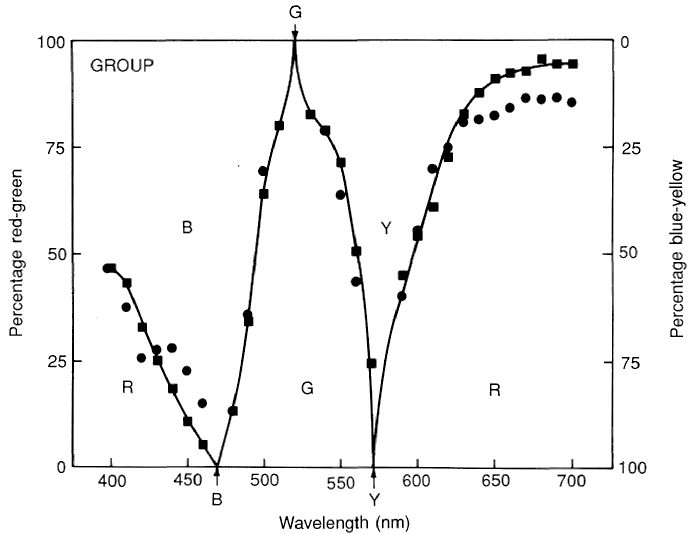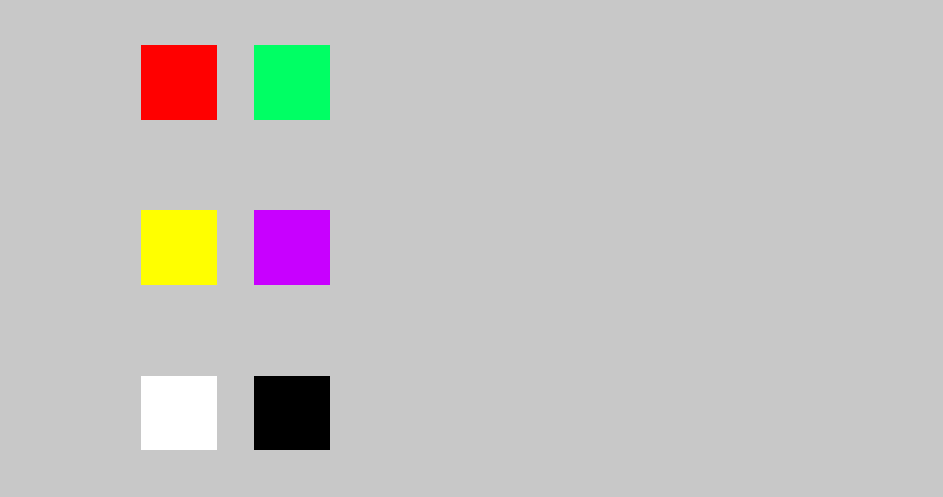
Obviously color perception starts with the three different types of cone receptors in the retina which selectively respond to red (or L for long wavelength), green (or G for middle wavelength) and blue (or S for short wavelength). As discussed before, the color perception is based on the comparison of the responses of these three types of receptors. (This is also the reason why all perceivable colors can be represented in a 3D space spanned by a set of three axes, such as responses from L, M, and S, or three primary colors R, G, and B, or the CIE X, Y, and Z.) However, the three channels for L, M, and S in the retina are no longer present in the higher levels along the color processing pathway.
It is our everyday experience that some colors can be perceived simultaneously, such as red and yellow (orange), red and blue (purple), green and blue, yellow and green, etc. But some others can not, mainly, red and green, and yellow and blue. One never sees reddish green or yellowish blue.
Based on the observations of color opponency, Ewald Hering (German physiologist 1834-1918) postulated that there existed three opponent processes in our visual system (retina-brain): one for red-green, one for yellow-blue, and a third, qualitatively different from the first two, for black-white. Therefore in Hering's theory, there are three pairs of six primary colors: red and green, yellow and blue, and black and white.
Hering's theory is supported by hue-scaling experiment (Werner and Wooten 1979) in which observers describe the appearance of monochromatic lights from 400 to 700 nm by assigning percentages of red, green, yellow and blue. As shown in the figure, we can perceive reddish blue (magenta), bluish green (cyan), greenish yellow, and reddish yellow (orange), but we never perceive reddish green or bluish yellow. In other words, neither red and green, nor yellow and blue, are ever perceived simultaneously.

Also the hue cancelation experiment (Hurvich and Jamerson 1957) shows that red color can be ``canceled'' by green color, and so can yellow by blue, as shown in the figure. While presented with a monochromatic or spectral test light, the subject adjust the intensity of the ``canceling'' light so that the mixture of the test light and the canceling light appear neither red or green. The amount of red and green canceling light is shown by the curve (open triangles) with positive value for green and negative for red (both representing positive intensity). Because both ends of the spectrum look red, green light is needed to cancel the redness. The middle range of the spectrum appears green and red light is needed to cancel the greenness. The yellow-blue canceling curve (filled circle) is generated in a similar way with positive value for blue and negative for yellow.

Over half a century, Hering's theory seemed contradicting the Young-Helmholz's theory of three types of receptors for three primary colors. Physicists generally sided with the Young-Helmholz camp (probably for the quantitative approach such as simultaneous equations, etc.) and psychologists often sided with Hering (probably for their psychophysical experiences).
